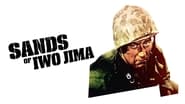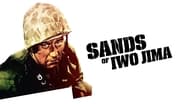smittynlinda
I was five years old when the Marines landed on Iwo, my eldest brother however was at Pharmacist Mate 3d (now Hospital Corpsman), with 3rd Marines at Iwo. He seldom ever spoke of it. Was called back in Korea, got a Silver Star with King Co., 3rd Bn., 7th Mar. in the vicinity of Sintanni, Nov. 1951. I enlisted in the Marine Corps, Plt. 344, San Diego, July 1959. Remember seeing the Sands of Iwo Jima on my first liberty from Lima Co., 2nd ITR, CAMPEN, as I'm sure many hundreds of Marines did, especially us new guys, in Oceanside, Ca. I digress: Seems like most of the time in the actions scenes the actors were either wearing field marching packs w/short blanket roll, or light marching pack, no blanket roll. While in the actual scenes, mostly the ones at Tarawa almost all the Marines were with out 782 gear (web gear)? Also Sgt. Stryker told them to hit the "sack". as I recall, and it's been many years, we used the term "hit the rack"? Moot points I'm sure, I'll probably watch it again, if fact I'm sure I will, and maybe have some more info as I recall it. Semper Fi
wes-connors
During World War II, bombastic Marine Sergeant John Wayne (as John M. Stryker) trains a diverse (for the time) group of younger men for the tough "Sands of Iwo Jima" battle. Deserted by his own family, Mr. Wayne develops fatherly affections for his recruits, while lambasting them. Wayne gets close to arrogant John Agar (as Peter "Pete" Conway), while bickering with him. You've got to wonder why Wayne trained anyone, when he could have easily won the battle of Iwo Jima by himself. Come to think of it, why didn't we just send Wayne to knock off Hitler, and be done with it? Since this film is so ludicrous, I decide to ask my aunt about the actors. Wayne was "a very handsome man," "opinionated" and "in charge" most of the time. Eventfully, he became the character "John Wayne". Agar grew a little too fond of alcohol as time went on, although "he was a very nice man." They would meet for drinks in beautiful downtown Burbank. If Agar had a few too many, and became "nasty," my aunt would sing a few choruses of "On the Good Ship Lollipop" to quiet him down. Okay, she said, "to shut him up!" Now that I see he was divorcing "Mrs. Agar", I know why that technique worked.Back to the film… It was nominated for several "Academy Awards" and is nicely produced. Several of the actual Marines serving at Iwo Jima appear. Director Allan Dwan, whose career date back to many successful "silent movie" features, brings a lot of experience to the film; he works well with Wayne and gets a more comfortable budget than usual, from the studio ("Republic"). Wayne solidified his superstar status with "Sands of Iwo Jima" and his iconic characterization received a "Best Actor" notice; but, see his "She Wore a Yellow Ribbon" (also 1949) for a better overall performance.****** Sands of Iwo Jima (12/14/49) Allan Dwan ~ John Wayne, John Agar, Forrest Tucker, James Brown
John T. Ryan
SOMEWHERE we recall seeing a review of the John Wayne starring vehicle, THE GREEN BERETS (Batjac Prod./Warner Bros.1968), which of course panned the picture as "applying World War II, SANDS OF IWO JIMA logic" to the (then) current Viet-Nam War and the involvement of Uncle Sam in it. WELL, Mr. Big Shot Movie Guy, we hate to disagree with your high level, cerebral and virtually error-free edicts; but the SANDS Picture was actually made in the post-war period; and may well have been one of the first movies of any stature to pay tribute to the great sacrifices given up by so many ordinary citizens, who were made into Wartime Leathernecks.WHEN we say "movies of any stature", we most usually would not be referring to any usual product of that Republic Outfit at 4024 Radford Avenue, Studio City, Los Angeles, California. Their output was more that of their famous assembly-line operation; not unlike those found in the old Chicago Stock Yards and the Ford Motor Company in Detroit. Although they came up with an occasional gem, such as Lewis Milestone's THE RED PONY (1949) and John Ford's THE QUIET MAN (1952), which many believe to have been Republic's finest moment. (Arguably).MORE familiar to the company was production of fodder for the Saturday Afternoon Matinée crowd, the kiddy crowd. The genres found plentiful in the yearly out-put were the Series or "B" Western and the Movie Chapter Play Serial/Cliff-Hanger; with the occasional Family-type Comedy thrown in, such as THE ATOMIC KID (Mickey Rooney Prod./Republic,1954) with Mickey Rooney and Robert Strauss.ACTION being a top ingredient of the real, Wartime made war pictures; one would think that Republic would be more than up to the task of bringing the world some "realistic" tales of the battles raging in Western Europe, North Africa, Southeast Asia, Russia, China-Burma-India and the South Pacific. After all, we see plenty of top rate action in FLYING TIGERS (Republic, 1942) and the SPY SMASHER Serial(Republic,1942); but also we have generous helpings of Anti-Nazi, Anti-Fascist and Anti-Imperial Japanese Militarist wartime propaganda woven through-out. We also know that 'propaganda' isn't necessarily a bad thing.* SANDS OF IWO JIMA, on the other hand, is not nor was it ever intended to be any such a sort of movie. As we previously mentioned, we believe that SANDS may well have been the first film to begin to deal with asking ourselves just what happened, what price did both those who died as well as those who survived pay and how we were blessed with a victory; preserving our freedoms for a new generation.WHEREAS the inherent brutality of combat in modern warfare was depicted in the fine battle scenes filmed, any sort of what might be considered to be politically incorrect remarks concerning "the Japs" are held to a minimum, if not excised completely.PROPERLY and in extremely good taste, the picture sticks to the very 'over-soul' of that organization we know as the United States Marine Corps and how a young man would relate to and get along as a member of it. Pride, History and Tradition all play a major role in the story. Told in an almost metaphorical tale from the points of view of the characters Sgt. Stryker (John Wayne), Pvt. Peter Conway (John Agar), Allison Bromley (Adele Mara-Woo,woo,woo,woo!), Pfc. Al Thomas (Forrest Tucker) and Mary (Julie Bishop), the tale becomes that of almost anyone from that strife-torn era. The usual collection of ethnic types and regional U.S. accents are represented; being in the capable hands of a great group of supporting repertory players such as: Wally Cassell, James Brown, Richard Webb, Arthur Franz, James Holden, Peter Coe, a young Richard Jaeckel, an even younger Martin Milner and others.INCLUDED in the film are many true-life Marine Heroes who lived the parts portrayed in the story; often as Officers and others with speaking roles. Of particular interest is the inclusion of Marine Pfc.'s Rene Gagnon, Ira H. Hayes and John H. Bradley; who are seen re-enacting their parts in raising the Stars & Stripes over Mt. Suribachi, signifying the victory over the Imperial Japanese forces on that atoll.IN paying proper tribute to the Republic Production crew and to Director Alan Dwan, we must mention the finely staged and filmed action scenes. The recreations of 'hitting the beach' in SANDS were exceptional; only being surpassed with Darryl F. Zanuch's THE LOMGEST DAY (1962). There was excellent use made of inter-cutting real Pacific Island battle footage with the movie scenes and the editing was overall, nearly flawless.RATHER than the rather smug and narrow-minded assessment of the film by the above mentioned Mr. Big Shot Movie Reviewer, we feel that SANDS OF IWO JIMA should go down in history as a great memory and tribute to our Fighting Marines in World War II from Hollywood, as well as its being possibly Republic Pictures finest hour. (Once again, Arguably).NOTE: * The word PROPAGANDA has long been viewed as a sort of 'dirty' word. This is due mainly to the usage is most often tied in with the activity of our enemies. We have grown accustomed to hearing of "Nazi Propaganda", "Communist Propaganda", "Feminist Propaganda", etc. But we all propagandize in order to get out our message and spread the word for our side, the American Way. A Plant Nursery will propagate a flower by planting its seeds and harvesting a far greater number than before. Even the Catholic Church has its Society for the Propagation of the Faith. (Just kidding about that "Feminist Propaganda" remark, Ladies!)







